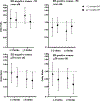Reproductive factors and risk of breast cancer by tumor subtypes among Ghanaian women: A population-based case-control study
- PMID: 32068253
- PMCID: PMC8380990
- DOI: 10.1002/ijc.32929
Reproductive factors and risk of breast cancer by tumor subtypes among Ghanaian women: A population-based case-control study
Abstract
Higher proportions of early-onset and estrogen receptor (ER) negative cancers are observed in women of African ancestry than in women of European ancestry. Differences in risk factor distributions and associations by age at diagnosis and ER status may explain this disparity. We analyzed data from 1,126 cases (aged 18-74 years) with invasive breast cancer and 2,106 controls recruited from a population-based case-control study in Ghana. Odds ratios (OR) and 95% confidence intervals (CI) were estimated for menstrual and reproductive factors using polytomous logistic regression models adjusted for potential confounders. Among controls, medians for age at menarche, parity, age at first birth, and breastfeeding/pregnancy were 15 years, 4 births, 20 years and 18 months, respectively. For women ≥50 years, parity and extended breastfeeding were associated with decreased risks: >5 births vs. nulliparous, OR 0.40 (95% CI 0.20-0.83) and 0.71 (95% CI 0.51-0.98) for ≥19 vs. <13 breastfeeding months/pregnancy, which did not differ by ER. In contrast, for earlier onset cases (<50 years) parity was associated with increased risk for ER-negative tumors (p-heterogeneity by ER = 0.02), which was offset by extended breastfeeding. Similar associations were observed by intrinsic-like subtypes. Less consistent relationships were observed with ages at menarche and first birth. Reproductive risk factor distributions are different from European populations but exhibited etiologic heterogeneity by age at diagnosis and ER status similar to other populations. Differences in reproductive patterns and subtype heterogeneity are consistent with racial disparities in subtype distributions.
Keywords: breast cancer; racial disparities; reproductive risk factors; subtype heterogeneity.
Published 2020. This article is a U.S. Government work and is in the public domain in the USA.
Conflict of interest statement
Declaration of interests
Authors have no conflicts of interest to declare.
Figures



References
-
- Newman LA, Kaljee LM. Health Disparities and Triple-Negative Breast Cancer in African American Women: A Review. JAMA Surg 2017; 152(5): 485–93. - PubMed
Publication types
MeSH terms
Substances
Grants and funding
LinkOut - more resources
Full Text Sources
Medical

